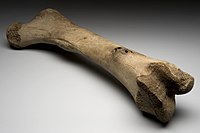
Photo from wikipedia
Purpose of the study: The purpose of the study was to examine on the basis of radiographic images of bone tissue, whether there are differences in the rate of bone… Click to show full abstract
Purpose of the study: The purpose of the study was to examine on the basis of radiographic images of bone tissue, whether there are differences in the rate of bone remodelling using different shapes of implants in the mandible and maxilla. Moreover, the study also compares texture features obtained on the basis of these images for healthy bone tissue, bone directly after implantation and after a 12-month period of prosthetic loading. Materials and Methods: The subject of the analysis was radiovisiogram images obtained from the Medical University of Bialystok from the Department of Dental Surgery. They are radiovisiogram photographs of 146 people aged 18–74, treated implantally due to missing teeth. The whole group of patients received two types of implants (Active and Replace) of the same company, made of titanium, intraosseous, screw-in. Results: It has been shown that both in the upper jaw and the mandible, the values of texture parameters obtained for bone images made after one year of prosthetic loading are closer to healthy tissue than immediately after implantation. These values for the mandible were relatively closer to those obtained on the basis of healthy tissue than those for the upper jaw. The bone around the implant with a single threading achieved better results in the mandible than the one with a double threading. Conclusion: The type of bone tissue and the shape of the implant have an impact on the achieved osseointegration. With the passage of time and the process of bone remodelling, the damaged tissue returns to its normal structure.
Journal Title: Signal, Image and Video Processing
Year Published: 2022
Link to full text (if available)
Share on Social Media: Sign Up to like & get
recommendations!